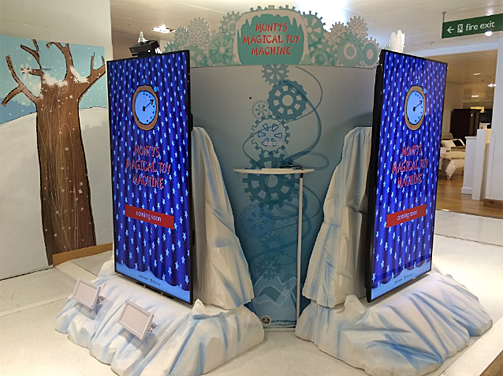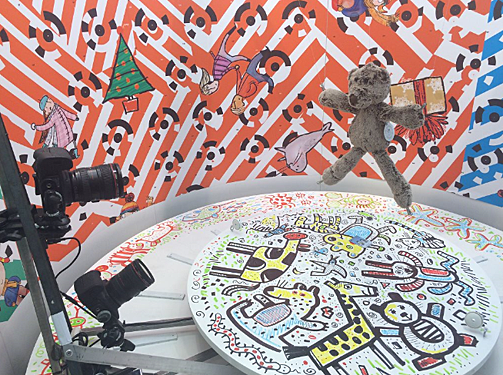The magic of Christmas, Kinect style
Every December, British shoppers look forward to the creative holiday ad campaign from John Lewis, a major UK department store chain. It’s been a tradition for a number of years, is seen by millions of viewers in the UK annually, and won a coveted IPA Effectiveness Award in 2012. The retailer’s seasonal campaign traditionally emphasizes the joy of giving and the magic of Christmas, and this year’s ads continue that tradition, with a television commercial that depicts the loving relationship between a young boy and his pet penguin, Monty.
[View:https://www.youtube.com/watch?v=iccscUFY860]
The 2014 Christmas advertisement from John Lewis tells the story of a boy and his penguin—and the
magic of giving just the right gift.
But the iconic British retailer has added a unique, high-tech twist to the 2014 campaign: Monty’s Magical Toy Machine, an in-store experience that uses the Kinect for Windows v2 sensor to let kids turn their favorite stuffed toy into an interactive 3D model. The experience deftly plays off the TV ad, whose narrative reveals that Monty is a stuffed toy that comes alive in the boy’s imagination.
Monty’s Magical Toy Machine experience, which is available at the John Lewis flagship store on London’s Oxford Street, plays to every child’s fantasy of seeing a cherished teddy bear or rag doll come to life—a theme that runs through children’s classics from Pinocchio to the many Toy Story movies. The experience has been up and running since November 6, with thousands of customers interacting with it to date. Customers have until December 23 to enjoy the experience before it closes.
The toy machine experience was the brainchild of Microsoft Advertising, which had been approached by John Lewis to come up with an innovative, technology-based experience based on the store’s holiday ad. “We actually submitted several ideas,” explains creative solutions specialist Art Tindsley, “and Monty’s Magical Toy Machine was the one that really excited people. We were especially pleased, because we were eager to use the new capabilities of the Kinect v2 sensor to create something truly unique.”
John Lewis executives loved the idea and gave Microsoft the green light to proceed. "We were genuinely excited when Microsoft presented this idea to us,” says Rachel Swift, head of marketing for the John Lewis brand. “Not only did it exemplify the idea perfectly, it did so in a way that was both truly innovative and charming.”
Working with the John Lewis team and creative agency adam&eveDDB, the Microsoft team came up with the design of the Magical Toy Machine: a large cylinder, surrounded by three 75-inch display screens, one of which is topped by a Kinect for Windows v2 sensor. It is on this screen that the animation takes place.

The enchantment happens here, at Monty's Magical Toy Machine. Two of the enormous display
screens can be seen in this photo; the screen on the left has a Kinect for Windows v2 sensor
mounted above and speakers positioned below.
The magic begins when the child’s treasured toy is handed over to one of Monty’s helpers. The helper then takes the toy into the cylinder, where, unseen by the kids, it is suspended by wires and photographed by three digital SLR cameras. The cameras rotate around the toy, capturing it from every angle. The resulting photos are then fed into a customized computer running Windows 8.1, which compiles them into a 3D image that is projected onto the huge screen, much to the delight of the toy’s young owner, who is standing in front of the display. This all takes fewer than two minutes.

Suspended by wires, the toy is photographed by three digital SLR cameras (two of which are
visible here) that rotate around the toy and capture its image from every angle.
The Kinect for Windows v2 sensor then takes over, bringing the toy’s image to life by capturing and responding to the youngster’s gestures. When a child waves at the screen, their stuffed friend wakens from its inanimate slumber—magically brought to life and waving back to its wide-eyed owner. Then, when the child waves again, their toy dances in response, amazing and enchanting both kids and parents, many of whom cannot resist dancing too.
The Kinect for Windows SDK 2.0 plays an essential role in animating the toy. Having added a skeletal image to the toy, the developers used the Kinect for Windows software development kit (SDK) 2.0 to identify key sequences of movements, thus enabling the toy to mimic the lifelike poses and dances of a human being. Because the actions map to those of a human figure, Monty’s Magical Toy Machine works best on toys like teddy bears and dolls, which have a bipedal form like that of a person. It also functions best with soft-textured toys, whose surface features are more accurately captured in the photos.
The entire project took two months to build, reports Tindsley. “We began with scanning a real toy with Kinect technology, mapping it to create a surface representation (a mesh), then adding in texture and color. We then brought in a photogrammetry expert who created perfect 3D images for us to work with,” Tindsley recalls.
Then came the moment of truth: bringing the image to life. “In the first trials, it took 12 minutes from taking the 3D scans of the toy to it ‘waking up’ on the screen—too long for any eager child or parent to wait,” said Tindsley. “Ten days later, we had it down to around 100 seconds. We then compiled—read choreographed and performed—a series of dance routines for the toy, using a combination of Kinect technology and motion capture libraries,” he recounts.
[View:https://www.youtube.com/watch?v=XBJqsJ9_-iU]
A teddy bear named Rambo Ginge comes to life through Monty's Magical Toy Machine, and, as this video shows, even adults are enraptured to see their priceless toys come alive.
None of this behind-the-scenes, high tech matters to the children, who joyfully accept that somehow their favorite stuffed toy has miraculously come to life. Their looks of surprise and wonder are priceless.
And the payoff for John Lewis? Brand loyalty and increased traffic during a critical sales period. As Rachel Swift notes, “The partnership with Microsoft allowed us to deliver a unique and memorable experience at a key time of year. But above all,” she adds, “the reward lies in surprising and delighting our customers, young and old.” Just as Monty receives the perfect Christmas gift in the TV ad, so, too, do the kids whose best friends come to life before their wondering eyes.
The Kinect for Windows Team
Key links